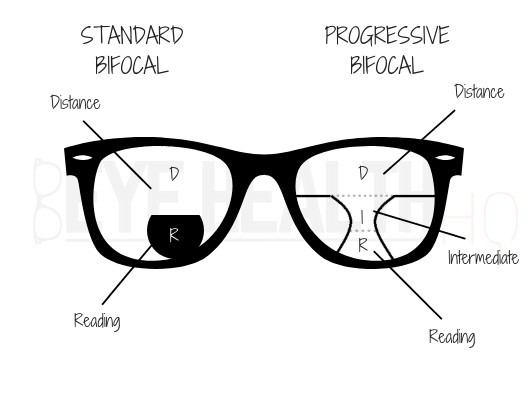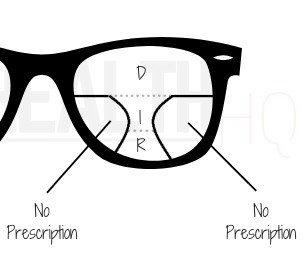Bear in mind that some of the links on this website are affiliate links. If you go through them to make a purchase we will earn a commission at no extra cost to you but helps support our website. Keep in mind that we link these companies and their products because of their quality and not because of the commission we receive from your purchases.
Progressive lenses commonly referred to as no-line bifocals, multifocal lens, or blended bifocals and are used by individuals who have trouble focusing on nearby objects, an age-related condition called presbyopia. This is a condition that generally happens to anyone around or above the age of 40, even if your vision was perfect before.
Table of Contents
Progressive Lenses Pros & Cons
While a standard line-bifocal could easily solve the problem of being able to see things up close. There are some people that may require progressive lenses just based on their day to day activities, or for work. Your eye doctor or optician helping you with your glasses may recommend progressive lenses, but progressive lenses may come at a much higher price tag than standard bifocals or trifocal lenses. What are the benefits of wearing a progressive lens? Below you will find the pros and cons of progressive lenses.
What Are Progressive Lenses?
As I mentioned, progressive lenses are for individuals with presbyopia, which is a normal loss of near focusing ability that occurs with age. A progressive lens gives you the ability to be able to see things that three different distances without having to switch between different glasses. It allows you to be able to see things at a distance (such as watching tv), at an intermediate range (such as a computer), and close up (such as your smartphone).
You may be thinking well a trifocal could do the same thing, but the main difference between a progressive and a standard bifocal or trifocal is the gradual blend between the three different prescriptions. The lenses are seamless and do not have any distinct visible line, which is the reason why people call them “no-line bifocals”. See the illustration below.
 As you can see in the illustration above on the left is what a standard bifocal lens looks like. All the area on the top is for your distance for seeing far away, and that black half circle on the bottom is where your reading area is. With a standard bifocal, the reading area there that is indicated in black is visible to someone that is looking at you. This is one of the reasons why some people do not like to use the standard bifocal, they feel like the visible reading area may make you “look old” and the progressive provides a more youthful appearance. With standard bifocal lenses, there is an issue called image jump, due to the drastic shift between the two different prescription powers when you switch between one to the other.
As you can see in the illustration above on the left is what a standard bifocal lens looks like. All the area on the top is for your distance for seeing far away, and that black half circle on the bottom is where your reading area is. With a standard bifocal, the reading area there that is indicated in black is visible to someone that is looking at you. This is one of the reasons why some people do not like to use the standard bifocal, they feel like the visible reading area may make you “look old” and the progressive provides a more youthful appearance. With standard bifocal lenses, there is an issue called image jump, due to the drastic shift between the two different prescription powers when you switch between one to the other.
On the right-hand side of the illustration above you have the progressive lens. With the progressive lens, you have three areas of vision. On the top is your distance which is used to see anything further than your arm’s length away such as your television, or driving. Right below that is your intermediate, which is for anything at about arm’s length away such as a computer monitor, or your laptop. Lastly right below the intermediate area is the reading area, which would be at the length you would normally hold a book while reading it, your smartphone, or tablet. This is all a blended lens so you wouldn’t see any of those lines that you see in the illustration above, the illustration is just to show you approximately where the variation in power starts and ends. Because the progressive bifocal has no line and is a gradual power shift between distance to reading, you do not encounter the image jump issue. One minor issue with progressive lenses is the distortion on your peripheral vision. Take a look at the illustration below.
 On either side of your lenses on a progressive lens have areas that have no prescription. Therefore if you needed to look at something in your peripheral vision, you wouldn’t be able to simply move your eyes in that direction but you would have to physically turn to look at something. Not all progressive lenses are created equal, premium progressive lenses have less of this distortion area, we’ll touch more on that later.
On either side of your lenses on a progressive lens have areas that have no prescription. Therefore if you needed to look at something in your peripheral vision, you wouldn’t be able to simply move your eyes in that direction but you would have to physically turn to look at something. Not all progressive lenses are created equal, premium progressive lenses have less of this distortion area, we’ll touch more on that later.Who Should Wear Progressive Lenses?
Anyone that needs a prescription to help them see when they are performing any close-up work such as reading could benefit from using progressive lenses. This is something that generally happens when you are over 40 years old. However, there are certain occupations where progressive lenses would be more beneficial than using a standard bifocal or single vision reading glasses. People in such occupations such as nursing, waiter, secretary, or anyone that often uses a computer would benefit from using progressive lenses. With everything, there are pros and cons to using progressive lenses and it may not work for everyone, let’s take a look. 
Pros
- Viewing Comfort – Because the power change between your distance and up close vision is gradual you won’t have the image jump that you would get from standard bifocals or trifocals.
- Computer Distance – Having the intermediate range is a huge benefit for progressive lenses. Sure you can say the lined-trifocal can do the same thing but the image jump and viewing area can be quite limited on a lined-trifocal.
- No Line – This is the most obvious benefit with progressive lenses, there is no visible line that you can see on the lens itself. This is one of the major reasons why people pick a progressive over a lined-bifocal or trifocal.
- Convenience – Since the progressive lens provides you with three viewing distances, you no longer have to carry around two or three pairs of glasses to be able to see at different distances.
Cons
- Adjustment – It does take some time to get adjusted to progressive lenses. This time will vary from person to person, some people can put them on and everything is perfect to them, and others it could take a week or two to get fully adjusted to them. Some people just can’t get used to progressive lenses at all.
- Peripheral Vision – As mentioned above, on the edges of your progressive lenses there are areas in which there is no vision correction and is a distortion area. This can be hard to get used to for some people and could cause some people to feel dizzy. Individuals who rely on their peripheral vision such as truck drivers tend to have a hard time with this as they rely on their peripheral vision to look at the mirrors while driving.
- Cost – Progressive lenses can be costly, most optical retailers whether it be at your local retailer or online the price difference between single vision lenses can progressives is at the very least around $100.
Types of Progressive Lenses
I had mentioned earlier that not all progressive lenses are created equal, there are different levels of progressive lenses and new technology have made progressive lenses even better than they were before. Things such as lens material, lens design, and add-ons could influence the cost of your progressive lenses, and ultimately the progressive lens that you are going to end up going with is going to depend on what your budget is.. Take a look at the types of progressive lenses below.
- Standard Progressive Lens – These are your entry level progressive lenses. If you are new to progressive lenses and you aren’t sure if you are going to like them or not this is a good place to start. Standard progressive lenses will generally require a minimum of 17mm from where your pupil is down to the bottom of the frame, If you get a frame that is too small, then you might cut off some of the reading areas on the bottom.
- HD Progressive Lenses – These lenses are available thanks to a new manufacturing process that has made it possible. The most popular type of HD lenses is called free-form lenses. These type of lenses are optimized to the wearer through computer-controlled equipment that makes an extremely precise lens. Some types of HD lenses even account for how far the frames are sitting away from the wearer for even better lens accuracy.
- Short Corridor Progressive Lenses – When standard progressive lenses were first introduced, there was always a minimum size your frame had to be to be able to use progressive lenses. These progressive lenses are designed to be able to fit into smaller sized frames. The downside to these lenses is that because the corridors for your intermediate and reading area are shorter it can be difficult to get adjusted to these if you are a first-time wearer.
- Wide Corridor Progressive Lenses – These lenses will have a wider intermediate and reading area for you to see through. Wide corridor progressive lenses are great for anyone who wants to be able to look at things that are wide across without having to move your head a lot. Generally, the wider corridor progressive lenses are easier to get adjusted to as there is less distortion in the peripheral vision and a wider area for your intermediate and reading area.
- Polarized Progressive Lenses – These are lenses for individuals who need to wear progressive lenses, but want to be able to protect their eyes from the harsh sunlight rays. Polarized lenses can be beneficial for those who go fishing, or spend time around snow. The UV rays from the sun could leave you with an unwanted sunburn. Progressive lenses are available in non-prescription sunglasses with UV protection as well.
- Photochromic/Transition Progressive Lenses – Photochromic or Transition progressive lenses would be great for anyone who wants to jump between going indoors and outdoors without having to switch their glasses back and forth. These lenses automatically darken when they are exposed to UV light, and is a great choice for protecting your eyes from the harmful UV rays from the sun. ]
Tips For First Time Progressive Wearers
If you are thinking about wearing progressive lenses, or perhaps your a new progressive lens wearer follow these tips so you are sure to have a smooth experience with your new progressive lenses.
- Picking An Optical Retailer – When you are trying to decide on what retailer to pick, I would recommend to check with any retailer that you are interested in and see what type of progressive lenses they carry. Not all retailers will carry the same brands of lenses, so be sure to ask a lot of questions so you get a progressive lens that suits your needs.

- Picking A Frame – In order for you to be able to see as clearly as you are supposed to at all three distances, you should pick a frame that is large enough to fit the progressive lenses. Your optician should be able to assist you in picking out frames that would be ideal for their selection of progressive lenses. As I mentioned above, there are short corridor progressive lenses designed to fit into smaller frames. Check with your optician for more information on those.
- Picking Your Lenses – This is where you would ask a lot of questions, and your optician should be able to explain the different lenses that specific retailer sells. You should get one that best suits your needs whether it be a wide corridor progressive lens or a Transition progressive lens. Your optician should be able to give you enough information so that you can make an informed decision on which lenses to go with.
- Learning To Use Your Lenses – If you are a new progressive wearer, even if you are an experienced progressive wearer, sometimes putting on a new pair of progressive lenses could take getting adjusted to. I always recommended my first-time progressive wearers to get home and put on their glasses, turn on the TV, and grab something to read. Whether that be a book or your smartphone, and practice looking up towards the TV and down towards your book or phone, now move the book or phone to the side without moving your head. The text on there should go out of focus, but if you point your nose towards it everything will clear right up. It will help you understand more about where the power gradually changes, and where your distortion areas on your peripheral vision are.
- Give Yourself Time – If you do not adjust to your progressive lenses right away, you should give yourself some time to get adjusted to your new lenses. I usually recommend to wait about a week and at the very max two weeks. If you are still having issues with your progressives after two weeks, either you should go back to your optical retailer to troubleshoot what the problem could be. You could need a recheck with your eye doctor, or it could just be a simple adjustment with the optician. Also, it is important to remember to not jump back and forth between your old glasses and new glasses during this adjustment period.
Final Thoughts
The days of having to deal with that obvious line in the middle of your lens to be able to read, or having to carry multiple pairs of glasses around are long gone thanks to modern technology.
Have you used progressive lenses before? Do you like them? I would love to hear from you, if you have any questions don’t hesitate to ask below and I will get back to you as soon as I can.
